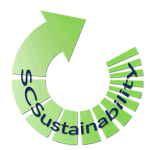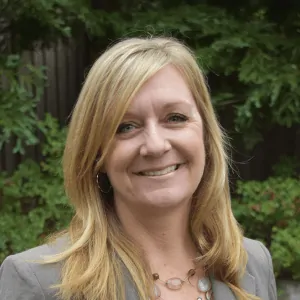

 Everyone knows about recycling, especially if you work at SCS. Many times, there are different ways that you can reuse those items for something else before, or instead of, getting rid of them. Today, we are sharing easy zero waste tips to repurpose items you have around your house, rather than just tossing them in the recycle bin:
Everyone knows about recycling, especially if you work at SCS. Many times, there are different ways that you can reuse those items for something else before, or instead of, getting rid of them. Today, we are sharing easy zero waste tips to repurpose items you have around your house, rather than just tossing them in the recycle bin:
Author: Jennifer Mancini

Caroline Larose was awarded the Robert P. Stearns – SCS Engineers Master’s Scholar this year. Her project, “Material Flows: Strategies to Reduce Ann Arbor’s Municipal Solid Waste and Improve Diversion,” consists of a comprehensive benchmarking analysis of urban waste programs and a review of city stakeholders to distill a set of MSW management, education, and awareness best practices. Following her research, Caroline plans to draft recommendations for the City, which will include updated MSW goals and an action plan to improve diversion and reduce waste creation.
About Caroline Larose
Caroline chose to go back to school to further her pursuit of making cities more sustainable. She identified solid waste as her primary research focus and has worked towards her idea of eliminating waste as a concept. Caroline is now in her third year as a dual MBA/MS student at the Erb Institute for Global Sustainable Enterprise at the University of Michigan.
Caroline works to promote waste reduction and diversion on campus and throughout the Ann Arbor community by advising the implementation of campus-wide composting and uniform bin signage, as well as by organizing events such as the first Ross School of Business Waste Audit & Education Day and annual clothing swaps. Caroline, a member of the University-wide Student Sustainability Initiative board, has served as the VP of Sustainability for the Ross Net Impact chapter for 2-years. As a result of her leadership on campus, Caroline was selected to join the Ann Arbor Resource Management Team, advising the City of Ann Arbor on how to reduce its solid waste and improve diversion.
By Michelle Leonard, Solid Waste Planning and Recycling; Sustainability
National Expert
The term describes the desired end-state and a call-to-action rethinking what we regard as trash as potentially valuable resources. The overall goal of zero waste planning is to establish the goal of diverting at least 90 percent of the waste generated by all sources from a landfill.
Zero Waste is to:
Communities across North America have embraced the concept of Zero Waste, some by adopting a Zero Waste goal or policy, and others by completing a Zero Waste Plan. The plan includes implementing zero waste programs and infrastructure in a manner most sustainable for the community. Many communities establish a long-term goal of Zero Waste by setting interim goals to achieve and benchmark measuring progress. Goals may be quantified over years, by percentages, or by environmental factors relevant to your community.
There are several factors critical to sustainable Zero Waste programs.
Phasing in programs encourages acceptance of new policies, programs, and facilities, and the behavior modifications that come with them. Instead of continuing to focus on results at the end of the process, we find ways to fulfill the equation “waste = resource” within our industrial and societal systems. This mindset change helps to lead us to more systems that eliminate wastes to the environment, avoiding systematic deterioration of the environment. These systems are modeled by nature as the most efficient, less costly, and most profitable ways to move toward Zero Waste.
Programs that contribute to Zero Waste include upstream policies and programs. Over 71% of the waste generated happens before products and materials enter our homes, offices, schools and institutions. Upstream policies and programs aim to reduce the volume and toxicity of discarded products and materials and promote low-impact or reduced consumption lifestyles.
Producer Responsibility is an upstream activity, including advocacy at the state level and implementation of local ordinances for hard to handle materials, such as pharmaceuticals, sharps, batteries, CFLs. Local jurisdictions can support state legislation for Extended Producer Responsibility for materials such as carpet paint, etc.
Downstream programs aim to ensure the highest and best use of products and packaging at the end of their useful lives. They establish a hierarchy of:
Managing these materials will most likely require a combination of facilities which may include:
The issue of how Waste to Energy fits into a Zero Waste system has been a hotly debated topic at many Zero Waste conferences, workshops, and planning sessions. The Zero Waste International Alliance includes in its definition “no burning or burying”. However, even the most aggressive, advanced Zero Waste system will still have some residual materials, and these materials will need to be managed. Some cities that have adopted Zero Waste plans and/or policies include waste to energy in their strategic plans. These cities recognize that Zero Waste policies and programs will achieve a high diversion rate, but they also acknowledge that a portion of the waste stream residuals will need to be disposed or processed. For these cities, waste to energy, or another alternative technology facility will fill that need, and will further reduce the use of landfill disposal.
Learn more about Sustainable Materials Management
by Tracie Onstad Bills, Northern California Director, Sustainable Materials Management at SCS Engineers
For many years source separation was the primary method for recycling. However, technology has changed how recyclables are collected and processed. China, the largest importer of materials for recycling now strictly enforces regulations on importing contaminated materials for recycling into the country. China’s Operation Green Fence puts restrictions on what material China will accept, rejecting materials that don’t meet higher standards of cleanliness; that means rejected materials get buried in a landfill instead of being recycled.
Regardless of the type of recycling program, the biggest challenge here at home is now minimizing contaminated recycling material. Communities are struggling to meet diversion goals and provide materials to local recyclers that are free of common contaminants such as liquids left in containers or motor oil. My SCS team has assisted communities in the last few years to address contamination issues and I’d like to share what works best to kick start addressing the issue at home.
Recycling Assessments: Conduct a visual and physical characterization study to identify contamination levels using one of these two methods for the evaluation:
Recycling Technical Assistance: Meet with local businesses and perform a walk-through of their facility to collect baseline waste assessment and material collection infrastructure information. This information can then be used to provide customized recycling and composting recommendations, and implementation support such as employee training sessions, providing signage and collateral, referrals, and multi-lingual outreach services.
Review and Analysis of Community Recycling Programs: Review and analyze your recycling program. An environmental engineer can provide recommendations and assessments on how a recycling program can be enhanced to reduce the quantity of contaminated materials. Services typically include everything from examining outreach materials to the flow of the recycling from generation to transport to processing.
Planning and Implementation of Behavior Change Programs: There is value in providing comprehensive programs and explicit outreach materials for increasing the probability of cleaner recycling. Behavior change programs focus on planning and implementing programs that identify key triggers to encourage action in the community. These programs help communicate the importance and value of specific activities to the community and cross any age and cultural barriers.
Contamination is a global problem and is challenging, but there are steps to minimize the problem in your community.

About Tracie Onstad Bills
Tracie Onstad Bills has been in the Environmental and Resource Material Management Field for over 20 years. Her expertise revolves around commercial recycling technical assistance, environmental purchasing, large venue and event zero waste programs, research and sustainability planning, garbage hauler franchise compliance and review, construction and demolition program / ordinance analysis and writing, climate inventory compilation, research and feasibility studies to help clients with comprehensive waste prevention and zero waste programs. Ms. Bills has a BA in Environmental Science from San Jose State University, is a CRRA Board member and belongs to the SWANA Gold Rush Chapter, National Recycling Coalition and the Northern California Recycling Association. Contact Tracie here.
Learn more on the SCS service pages and read SCS project case studies from across the nation to help fine tune your program: